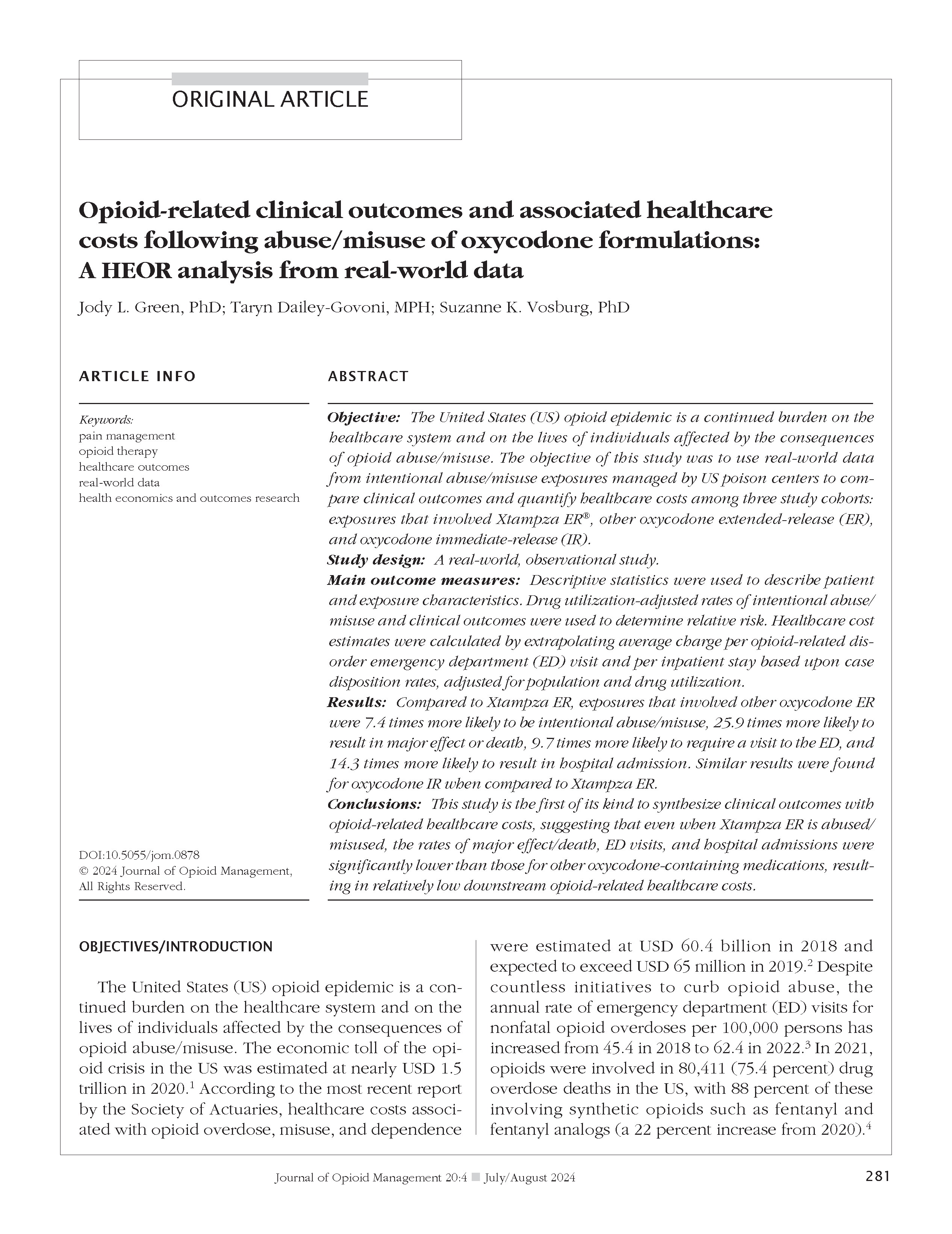Opioid-related clinical outcomes and associated healthcare costs following abuse/misuse of oxycodone formulations: A HEOR analysis from real-world data
DOI:
https://doi.org/10.5055/jom.0878Keywords:
pain management, opioid therapy, healthcare outcomes, real-world data, health economics and outcomes researchAbstract
Objective: The United States (US) opioid epidemic is a continued burden on the healthcare system and on the lives of individuals affected by the consequences of opioid abuse/misuse. The objective of this study was to use real-world data from intentional abuse/misuse exposures managed by US poison centers to compare clinical outcomes and quantify healthcare costs among three study cohorts: exposures that involved Xtampza ER®, other oxycodone extended-release (ER), and oxycodone immediate-release (IR).
Study design: A real-world, observational study.
Main outcome measures: Descriptive statistics were used to describe patient and exposure characteristics. Drug utilization-adjusted rates of intentional abuse/misuse and clinical outcomes were used to determine relative risk. Healthcare cost estimates were calculated by extrapolating average charge per opioid-related disorder emergency department (ED) visit and per inpatient stay based upon case disposition rates, adjusted for population and drug utilization.
Results: Compared to Xtampza ER, exposures that involved other oxycodone ER were 7.4 times more likely to be intentional abuse/misuse, 25.9 times more likely to result in major effect or death, 9.7 times more likely to require a visit to the ED, and 14.3 times more likely to result in hospital admission. Similar results were found for oxycodone IR when compared to Xtampza ER.
Conclusions: This study is the first of its kind to synthesize clinical outcomes with opioid-related healthcare costs, suggesting that even when Xtampza ER is abused/misused, the rates of major effect/death, ED visits, and hospital admissions were significantly lower than those for other oxycodone-containing medications, resulting in relatively low downstream opioid-related healthcare costs.
References
Joint Economic Committee Democrats: The economic toll of the opioid crisis reached nearly $1.5 trillion in 2020. 2022. Available at https://www.jec.senate.gov/public/_cache/files/67bced7f-4232-40ea-9263-f033d280c567/jec-cost-ofopioids-issue-brief.pdf. Accessed July 10, 2024.
Davenport S, Weaver A, Caverly M: Economic impact of non-medical opioid use in the United States, annual estimates and projections for 2015 through 2019. Society of Actuaries. 2019. Available at https://www.soa.org/globalassets/assets/files/resources/research-report/2019/econ-impact-non-medicalopioid-use.pdf. Accessed July 10, 2024.
Centers for Disease Control and Prevention: Drug Overdose Surveillance and Epidemiology (DOSE) System: Nonfatal Overdose Emergency Department and Inpatient Hospitalization Discharge Data. Atlanta, GA: US Department of Health and Human Services/CDC, 2023. Available at https://www.cdc.gov/overdose-prevention/data-research/facts-stats/dose-dashboardnonfatal-discharge-data.html?CDC_AAref_Val=https://www.cdc.gov/drugoverdose/nonfatal/dose/discharge/dashboard/index.html. Accessed July 10, 2024.
Spencer MR, Miniño AM, Warner M: Drug overdose deaths in the United States, 2001–2021. In NCHS Data Brief No. 457. Hyattsville, MD: National Center for Health Statistics, 2022. DOI: 10.15620/cdc:122556. Accessed July 10, 2024. DOI: https://doi.org/10.15620/cdc:122556
Dowell D, Ragan KR, Jones CM, et al.: CDC clinical practice guideline for prescribing opioids for pain—United States, 2022. MMWR Recomm Rep. 2022; 71(RR-3): 1-95. DOI: 10.15585/MMWR.RR7103A1. DOI: https://doi.org/10.15585/mmwr.rr7103a1
United States Food and Drug Administration CDER: Abuse deterrent opioids—Evaluation and labeling, guidance for industry. 2015. Available at https://www.fda.gov/downloads/Drugs/Guidances/UCM334743.pdf. Accessed November 16, 2023.
Green JL, Bucher Bartelson B, Le Lait MC, et al.: Medical outcomes associated with prescription opioid abuse via oral and non-oral routes of administration. Drug Alcohol Depend. 2017; 175: 140-145. DOI: 10.1016/j.drugalcdep.2017.01.039. DOI: https://doi.org/10.1016/j.drugalcdep.2017.01.039
Coplan P, Kale H, Sandstrom L, et al.: Changes in oxycodone and heroin exposures in the national poison data system after introduction of extended-release oxycodone with abuse-deterrent characteristics. Pharmacoepidemiol Drug Saf. 2013; 22(12): 1274-1282. DOI: https://doi.org/10.1002/pds.3522
Severtson S, Bartelson B, Davis J, et al.: Reduced abuse, therapeutic errors, and diversion following reformulation of extended-release oxycodone in 2010. J Pain. 2013; 14(10): 1122-1130. DOI: https://doi.org/10.1016/j.jpain.2013.04.011
Severtson SG, Kreider SED, Amioka EC, et al.: Post-marketing analysis of misuse, abuse, and diversion of Xtampza ER. Pain Med. 2020; 21(12): 3660-3668. DOI: 10.1093/pm/pnaa272. DOI: https://doi.org/10.1093/pm/pnaa272
Butler S, Cassidy T, Chilcoat H, et al.: Abuse rates and routes of administration of reformulated extended-release oxycodone: Initial findings from a sentinel surveillance sample of individuals assessed for substance abuse treatment. J Pain. 2013; 14(4): 351-358. DOI: https://doi.org/10.1016/j.jpain.2012.08.008
Green JL, Robbins RS, Dailey-Govoni T, et al.: Nonmedical use of Xtampza® ER and other oxycodone medications in adults evaluated for substance abuse treatment: Real-world data from the addiction severity Index-Multimedia version (ASI-MV®). J Pain Res. 2021; 14: 1773-1783. DOI: 10.2147/JPR.S304805. DOI: https://doi.org/10.2147/JPR.S304805
Petrilla A, Marrett E, Shen X, et al.: Association between formulary coverage and use of abuse-deterrent prescription opioids, risk for abuse or overdose, and associated healthcare resource utilization. Am Health Drug Benefits. 2020; 13(1): 21-31.
Department of Health and Human Services, Food and Drug Administration: Determination that the oxycontin (oxycodone hydrochloride) drug products covered by the new drug application 20-553 were withdrawn from sale for reasons of safety or effectiveness. Fed Regist. 2013; 78(75): 23273-23275.
Olatoke O, Zah V, Stanicic F, et al.: A US retrospective claims analysis comparing healthcare costs of patients transitioning from immediate-release oxycodone to two different formulations of extended-release oxycodone: Xtampza ER or OxyContin. Clinicoecon Outcomes Res. 2022; 14: 119-128. DOI: 10.2147/CEOR.S340290. DOI: https://doi.org/10.2147/CEOR.S340290
American Poison Centers: Available at https://www.aapcc.org/national-poison-data-system. Accessed November 16, 2023.
Gummin DD, Mowry JB, Beuhler MC, et al.: 2021 annual report of the national poison data system© (NPDS) from America's Poison Centers: 39th annual report. Clin Toxicol. 2022; 60(12): 1381-1643. DOI: 10.1080/15563650.2022.2132768. DOI: https://doi.org/10.1080/15563650.2022.2132768
US Food and Drug Administration: FDA analysis of long-term trends in prescription opioid analgesic products: Quantity, sales, and price trends. 2018. Available at www.fda.gov/media/111695/download. Accessed November 28, 2023.

Downloads
Published
How to Cite
Issue
Section
License
Copyright 2005-2025, Weston Medical Publishing, LLC and Journal of Opioid Management. All Rights Reserved.










